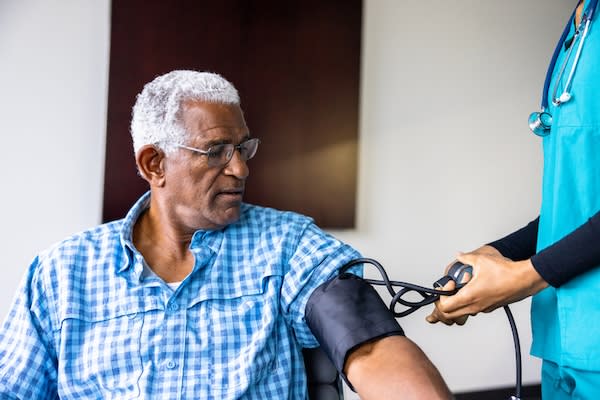Answering men’s prostate cancer questions
[4 MIN READ]
In this article:
-
Prostate cancer is highly treatable when caught in the early stages.
-
Prostate-specific antigen (PSA) tests are imperfect, but doctors strongly recommend them as part of an overall approach to screening for prostate cancer.
-
Urologist James Kuan, MD, offers expert insights about how men can work with their doctors to detect prostate cancer early and understand their treatment options.
Prostate cancer is the most common cancer in men, second only to skin cancer. One in eight men will get prostate cancer in their lifetime. The American Cancer Society estimates that in 2022, roughly 268,000 new cases of prostate cancer will be diagnosed and about 34,000 men will die from the disease.
The good news is that early detection and treatment save lives. We listened in on a recent conversation between Rick Malambri, host of the His Health podcast, and Dr. James Kuan, a board-certified urologist at Swedish, that shed light on this important topic. Here are some of the highlights.
The His Health podcast is produced by Providence Health System and is sponsored by Boston Scientific.
Q. Thanks for joining us again today, Dr. Kuan. Can you remind our listeners about your background?
A. Sure. I’m a urologist at Swedish in Seattle, specializing in men’s health – specifically male sexual dysfunction. Preventing, detecting and treating prostate is a big part of my practice.
Q. Let’s start with the basics. What is the prostate?
A. The prostate is a gland that only men have, and its primary function is sexual reproduction. The prostate produces semen, the fluid we release during orgasm that contains sperm.
The prostate sits below the bladder and is about the size of a walnut in a healthy man.
Q. What causes prostate cancer?
A. It’s usually a combination of factors – these might be environmental or hormonal or relate to lifestyle or family history. There may be genetic factors at play as well.
Q. Is prostate cancer considered to be an aggressive form of cancer?
A. In general, no. Most men diagnosed with prostate cancer will die of something else, even if their cancer has spread beyond the prostate. That said, there are aggressive forms of prostate cancer. When that’s the case, we can often manage the disease for many years before it leads to the complications we expect to see with advanced cancers.
Q. How treatable is prostate cancer?
A. When prostate cancer is diagnosed early, the cancer is contained within the prostate – it hasn’t spread to the bones or lymph nodes. This is the scenario for most men and their chances for survival are very good.
Q. Are screenings important in detecting prostate cancer early?
A. Yes. The workup for screening usually involves two important components – a finger exam (called a “digital exam”) of the prostate and a PSA blood test. PSA stands for prostate-specific antigen, a protein that only the prostate makes. A rising or elevated PSA is an indicator of potential prostate cancer.
The PSA test isn’t perfect, but urologists look at the results and put them in context with other indicators of risk, such as family history, the presence or absence of symptoms, how big or what the prostate feels like on exam, and whether the PSA level has changed over time. This “big picture” helps us decide whether a man may benefit from having a biopsy, which is the only way to diagnose prostate cancer definitively. A biopsy involves simply getting a tissue sample.
The screening process typically happens in the primary care office, and if there is a concern, the doctor will refer the patient to a urologist.
Q. When should men start getting screened?
A. The current recommendation is that men talk to their primary care doctor or urologist about getting screened when they are 55 years old. If a man has African American heritage or has a brother or father with a history of prostate cancer, their screenings should begin in their 40s.
Q. What are the treatment options for men with prostate cancer?
A.The mainstays of treatment for most men with prostate cancer are radiation therapy and prostatectomy (surgery to remove the prostate). Some men may have both radiation therapy and surgery – that’s often the case when the cancer is more advanced.
Active surveillance – what we used to call watchful waiting – is something we may discuss with men whose cancer is very low risk. Low risk means the man has a very low PSA level and his cancer is growing slowly and a biopsy shows only a small amount of tumor.
Active surveillance can involve getting PSA tests every three or six months, having repeat biopsies at various stages, and possibly getting magnetic resonance imaging (MRI) scans. This may be the best approach when we believe that a particular patient’s prostate cancer is so low risk that it may never become a problem in his lifetime. About 30 percent of men with prostate cancer can be on active surveillance.
So, not everybody gets the same treatment approach. But a discussion of all the options is necessary to help a man make informed treatment decisions.
Q. How does not having a prostate affect sexual function?
A. After a prostatectomy, a man can still have an orgasm but won’t ejaculate. That’s because the gland that produces semen is gone. This side effect can also occur after radiation therapy.
The other side effect men worry about is whether they will be able to have an erection after surgery. This depends on what happens during surgery. The two nerves that stimulate an erection sit on the surface of the prostate. If the surgeon can spare those nerves during surgery, there’s a pretty good chance the patient will be able to have an erection. However, the surgeon sometimes has to remove one or both of these nerves to get rid of the cancer cells. This will impact whether an erection is possible after surgery.
Q. What about urination?
A. The prostate is like a speed bump holding urine back. When a man doesn’t have a prostate anymore, we strongly recommend doing Kegel exercises to strengthen his pelvic floor. With Kegels, about 90% of men are continent one year after surgery, meaning they don’t have to wear a pad or anything like that to keep dry.
Q. How should men choose a surgeon if they need one?
A. There is very good data that says prostate surgery outcomes are better when surgery is performed by someone who has done a lot of prostatectomies. Most prostatectomies are done robotically, which is less invasive than open surgery. Compared to open surgery, minimally invasive surgery results in a shorter hospital stay and a faster return to your usual activities
At Swedish, we have a very established robotics program. In fact, we’re one of the highest volume hospitals on the west coast for robotic surgery. Our surgeons have done thousands of prostatectomies here, with excellent outcomes.
Q. What is the long-term follow-up like for men who have been treated for prostate cancer?
A. Longer term, these men will need to have follow-up PSA tests for the rest of their lives. A rising PSA level would indicate that maybe cancer has come back.
Fortunately, the five-year survival rate for men with localized prostate cancer is nearly 100%. However, up to 40% of men will experience a recurrence, so it is essential to understand your risk and get tested periodically. And be sure to talk to your doctor about any changes, side effects from treatment, or other concerns you may have.
--
Find a doctor
If you need to find a primary care doctor who specializes in men’s health, you can use our provider directory. Through Providence Express Care Virtual, you can also access a full range of healthcare services.
Download the Providence App
We’re with you, wherever you are. Make Providence’s app your personalized connection to your health. Schedule appointments, conduct virtual visits, message your doctor, view your health records, and more. Learn more and download the app.
Related resources
Food choices for a healthy prostate
When to schedule a prostate cancer screening
Have you been putting off your annual men’s wellness exam?
This information is not intended as a substitute for professional medical care. Always follow your healthcare professional’s instructions.



